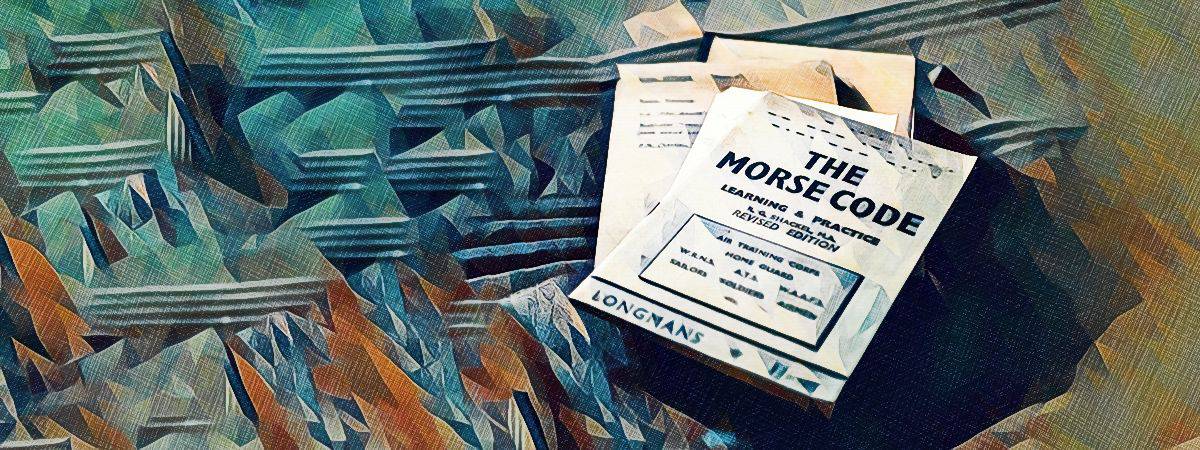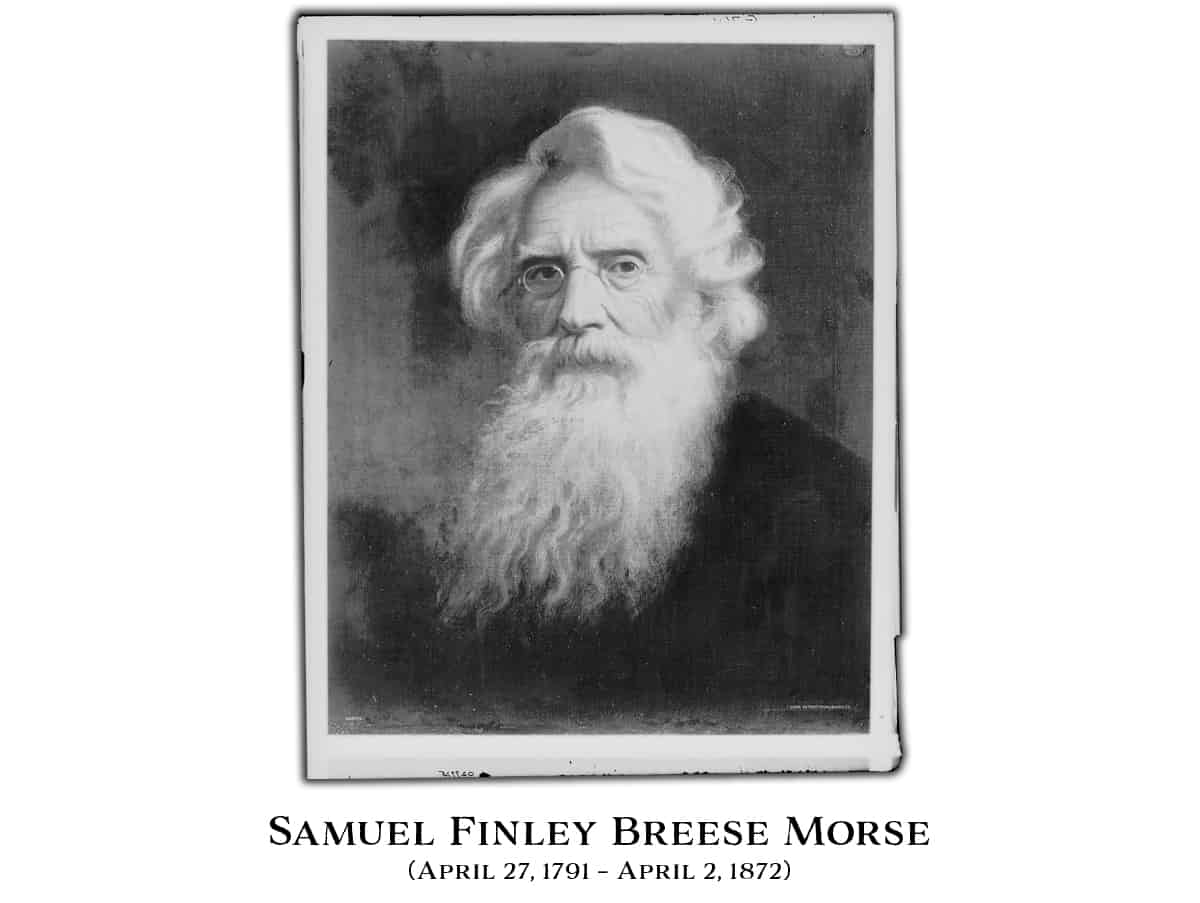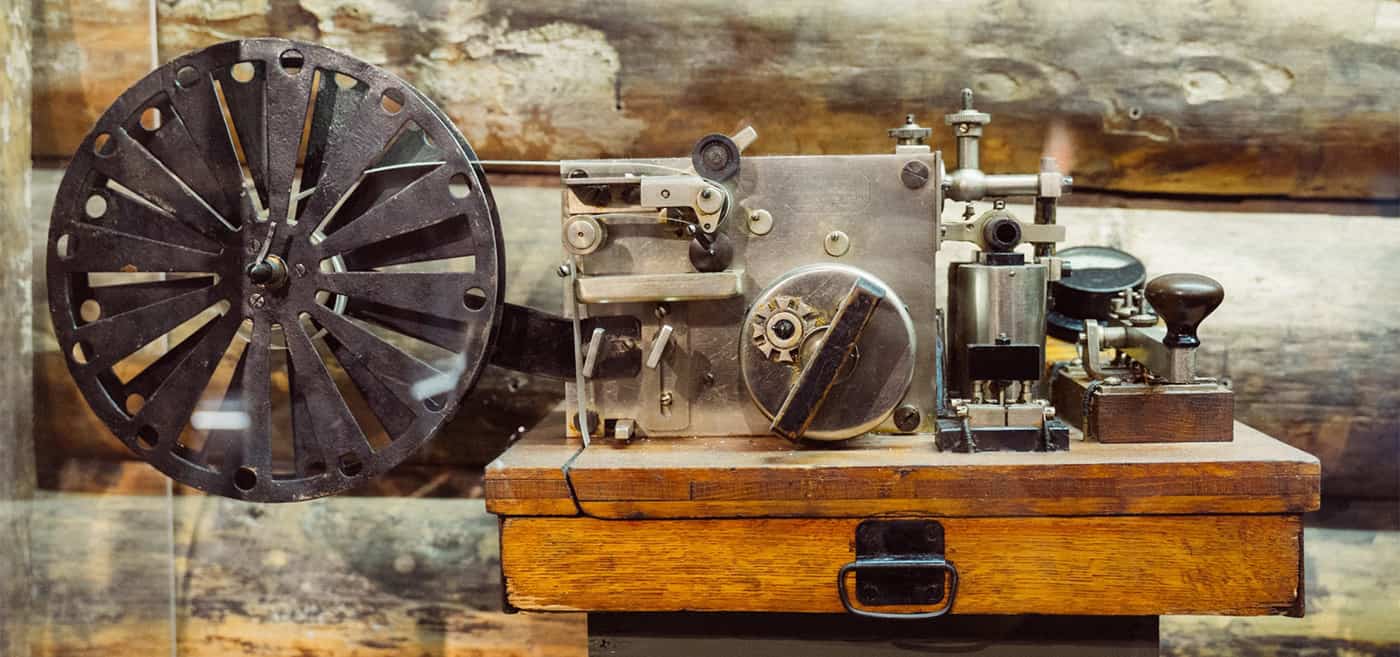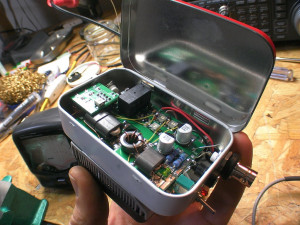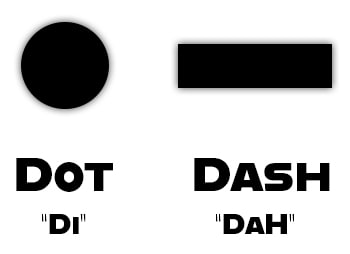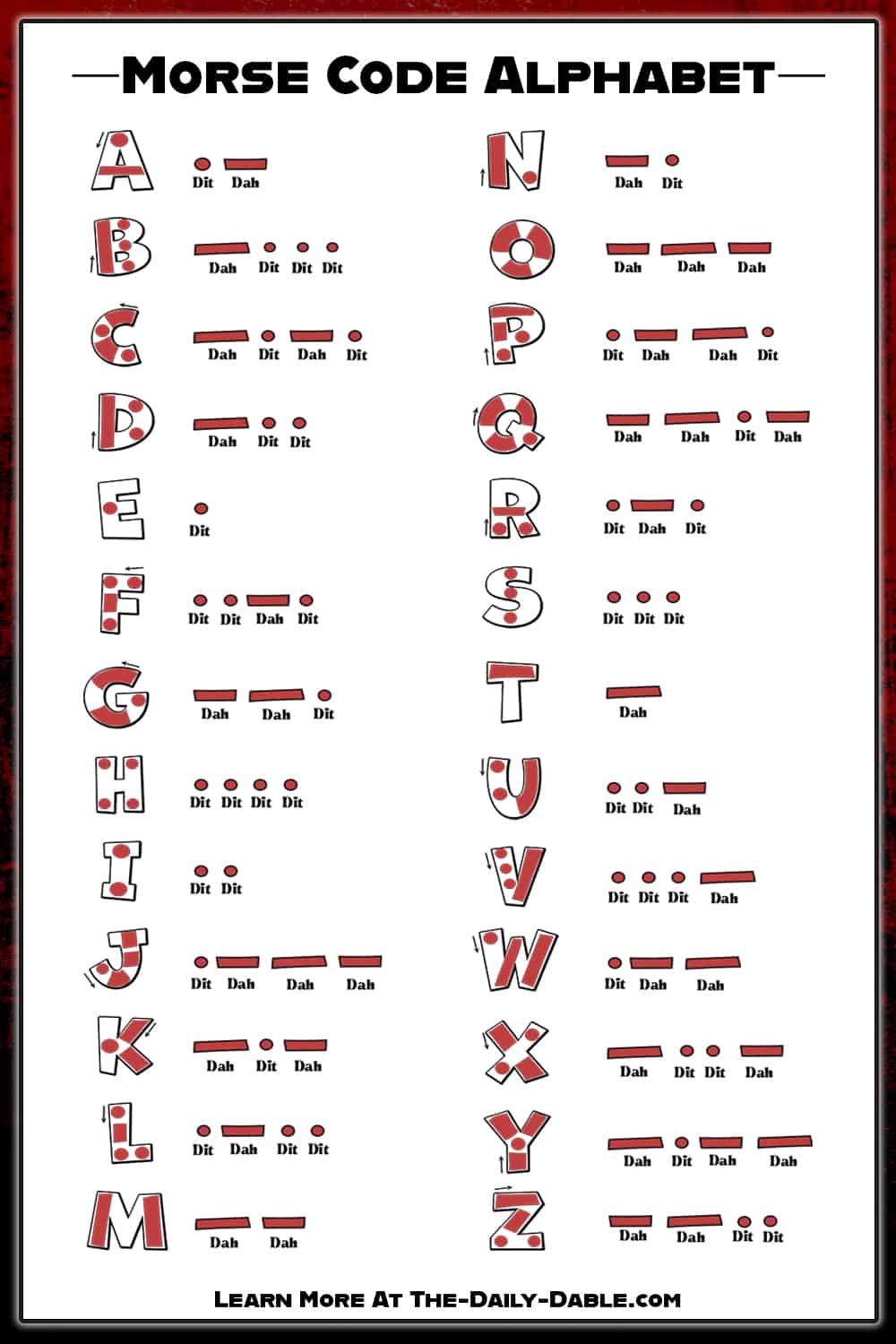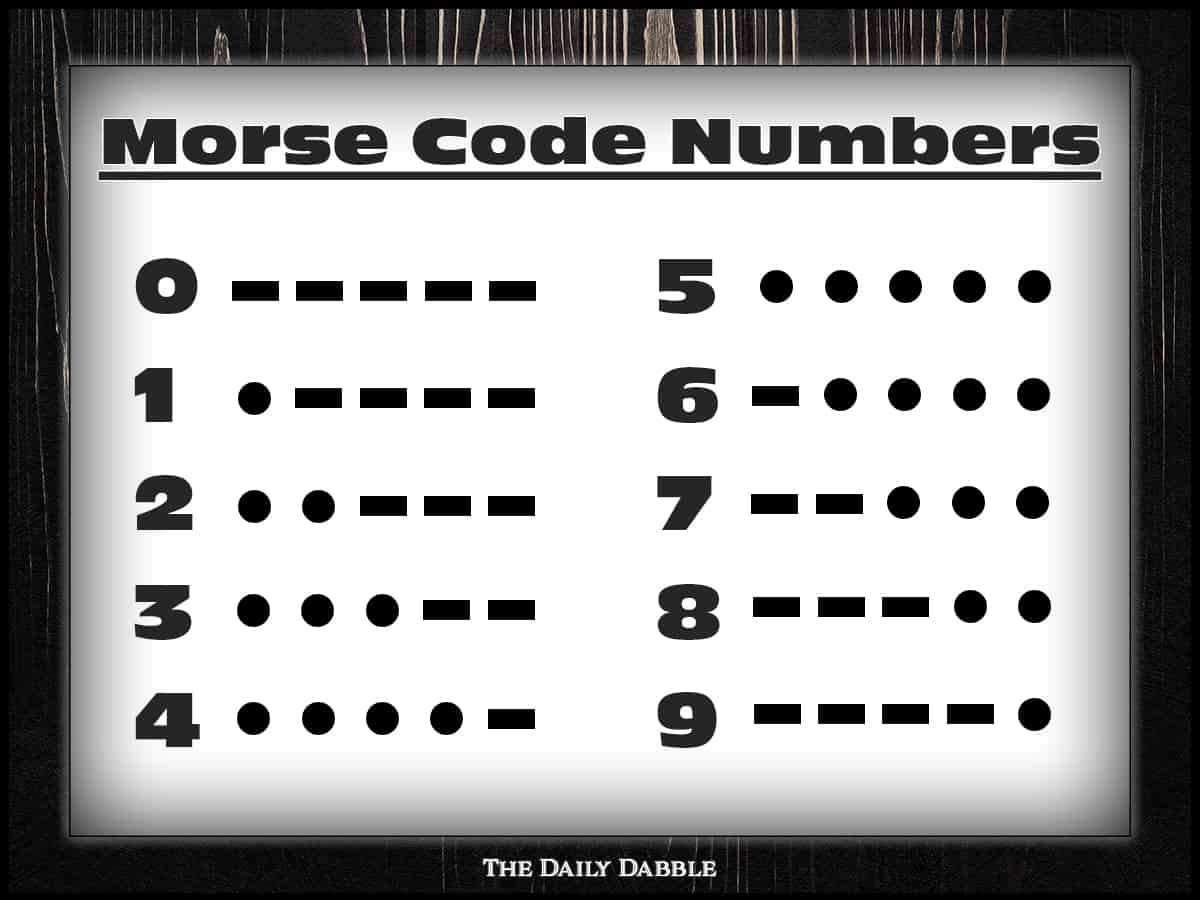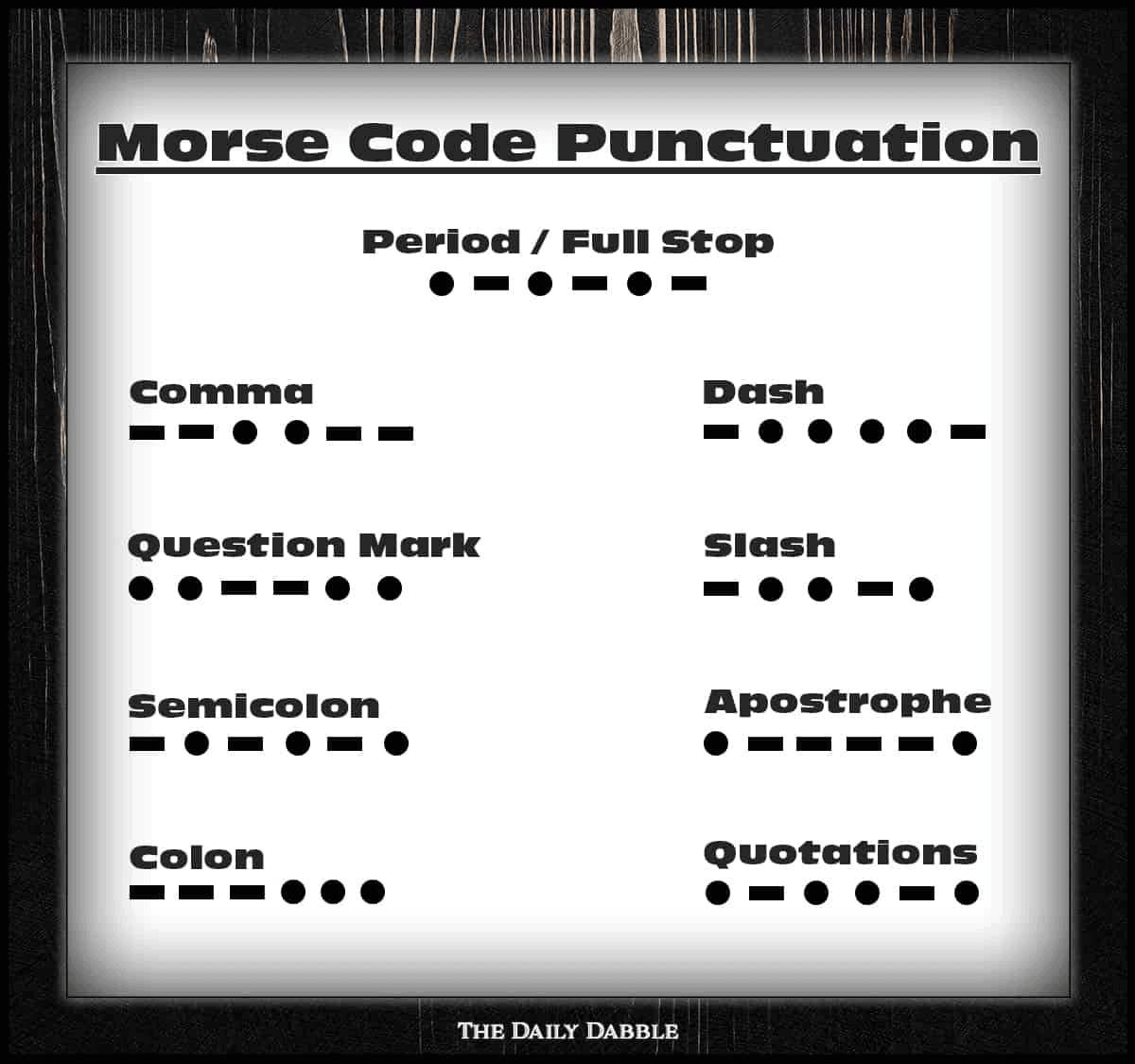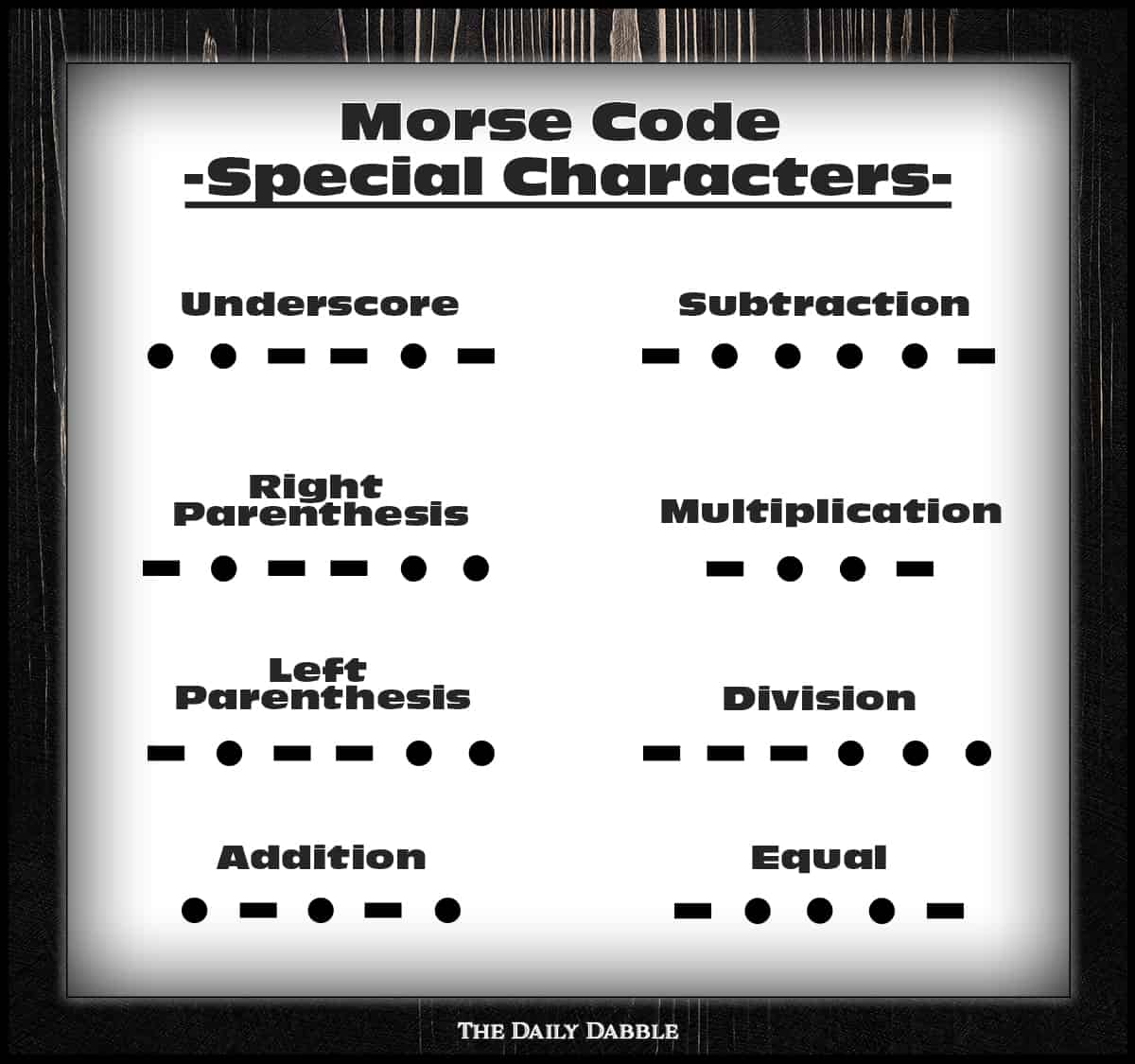Welcome to our morse code translator tool!
This is a simple tool that allows you to translate text to morse code and play the corresponding sound for each character in the translation.
To use the tool, simply type the text you want to translate in the upper text box. The tool will then translate the text to morse code and display the result in the then lower text box.
Once the text is translated, you can click on the “Play Sound” button to play the sound for each character in the morse code translation. The sound will play one character at a time, in the order that it appears in the translation.
Morse Code Translator / Decoder
Morse code was one of the most impactful technologies invented in the 1800s and has forever changed the way we interact with the world. It changed how we build and maintain relationships, it changed society, and it even changed how we fight wars.
And even today, in the age of quantum computing, there are still those—like yourself—that are interested in learning more about this seemingly ancient system of communication.
But before we get into the nitty-gritty, what exactly is the definition of Morse code?
Morse code is a telecommunication system used to encode text characters into a series of dots and dashes. Morse code is not a language but instead a method of encoding a language. It was first developed by Samuel Morse in 1837 and quickly gained traction in the Western world.
In this Morse code overkill guide, we’ll cover the fascinating history of Morse code, how it is used in the modern age, how to learn it, and so much more.
History of Morse Code
The history of Morse code is simple and short-lived.
That being said,
The invention and development of Morse code is one of the most revolutionary technologies of mankind that slung us into the era of technology that we thrive in today!
Let’s look at the history of Morse code; starting with its birth, then its life, and finally how its role as a critical technology died.
What Came Before Morse Code
Before Morse code and the invention of the electrical telegraph, long-distance communication was a challenging obstacle, not to mention devoid of LOLs and poop emojis.
Most messages were carried by horseback or delivered by messenger bird—both of which were limited by the animal’s speed.
For shorter distances, line-of-sight visual signals were used, such as smoke, flags, fire, or even semaphore systems that could use combinations of fire, flags, or even sunlight.
However, soon after the discovery of electromagnetism and the electromagnet, these older methods of communication were on the cusp of becoming obsolete.
In 1837, the first commercial electrical telegraph was developed and patented by William Fothergill Cooke and Charles Wheatstone.
Telegraph: Distant (‘tele‘) Writing (‘graphy‘)
The device allowed them to send coded pulses of electricity that would move a series of 5 needles on a grid of letters and numbers.
However, this five-needle system had a significant drawback. It required six cables to operate, which made it very expensive to install and scale.
This five-needle telegraph system was eventually innovated and replaced by a two-needle system, and a one-needle system quickly replaced that.
While the scaling issue had been fixed with the introduction of the single-needle telegraph system, it still had one last problem to face.
Because the needle was a visual cue, the operator had to split their attention between watching the needle and writing down letters, and unlike today, there was no rewind button if something was missed.
Who Invented Morse Code
In 1837 Samuel Morse and Alfred Vail developed and patented a new electrical telegraph that ran on one wire and could record received messages by simply marking dots and dashes with a stylus on a moving piece of paper.
This simple yet revolutionary technology allowed for a message to be recorded without the need for immediate translation.
Inspired by their own innovation, Samuel Morse and his assistant Alfred Vail set out to create a coded system that represented numbers and the entire alphabet. They optimized their code by breaking the alphabet down based on how frequently each letter was used in common speech.
They found the letter “e” was most frequently used and assigned it to a single dot. Contrast that to a less frequent letter such as “y,” which at the time was coded as “dot—dot——dot—dot.”
This brilliant coded system is what is known as American Morse Code, formerly known as Railroad Morse.
In March of 1843, US Congress allocated Samuel Morse $30,000—which is nearly a million dollars today—to lay wire between Washington D.C. and Baltimore. On May 24, 1844, the first message sent in Morse code was, “What hath God wrought?”
This was the first instantaneous text message in human history and paved the way for telecommunications as we know it and the memes that followed!
International Morse Code
American Morse code was a revolutionary technology, but as the rest of the world tried to adopt it, they ran into some problems.
The first problem was that it would cause distortion on longer lines due to its dot-heavy nature.
However, the greater problem was that Morse code is not a language and was instead a code mapped to the English language and would need to be altered to work with other languages.
In 1848 Friedrich Gerke proposed a solution to these two issues by introducing a new version of Morse code that removed many of the overcomplicated aspects of American Morse code—such as different length dashes and spacing rules.
This left only the dot and the dash.
He also added German vowels that allowed Gerke’s new Morse code to be adopted by Germany and Austria in 1851. In 1865 it was slightly modified and established as the official international Morse code standard.
This new international Morse code is universal and can be mapped to numerous alphabets and languages. Some countries whose language could not adapt to the international standard manifested their own versions, such as:
- Chinese Morse code
- Japanese Morse code (Wabun code)
- Korean Morse code (SKATS)
- Russian Morse code
- Spanish Morse code
- Greek Morse code
The Birth of Audible Morse Code
As Morse code operators gained proficiency in their craft, they also realized they could interpret the clicks of the telegraph directly into dots and dashes without the need to read a paper tape.
With the birth of radio communication, Morse code was thrown into a new era of audible transmission. Using radiotelegraph receivers, dots and dashes were replaced with unique sounds.
- Dots were represented with a short and rapid burst of sound “dit.”
- Dashes were represented with the more elongated sound of “dah.”
Additionally, to further speed up the reception of code, “dits” that were not the last component of a code were shortened to “di.”
For example, the letter “s” would sound like “di di dit.”
The move to audible Morse code further streamlined this communication system and revolutionized how we communicated with the rest of the world!
The Fall of Morse Code
Eventually, technologies such as radio, telephones, and the internet began to replace Morse code quickly. On July 2, 1999, the United States sent its last commercial communication using Morse code. It closed an era with the same message that started it all: “What hath God wrought.” with the prosign SK (“end of contact”).
However, this wasn’t the death of Morse code. The spirit and craft of this old style of communication are kept alive today by hobbyists and enthusiasts around the world.
How is Morse Code Used Today
Morse code is credited as one of the greatest innovations in human history and paved a path for all means of electrical communication to come.
The technologies that we all take for granted today, such as the telephone, texting, and even the internet, are all a result of Morse code and the telegraph.
But how is Morse code relevant today?
Even though Morse code isn’t as prominent as it once was, it is still used around the world in many ways.
Aviation Navigational Aids
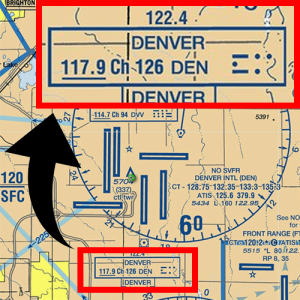
However, using Morse code to communicate in today’s aviation industry would be very deadly.
Today’s skies are very congested, and without quick communication from ground-based operations, such as air traffic control, aircraft separation would be near impossible.
While Morse code is no longer used to communicate in Aviation, it is still used for identifying ground-based navigation aids such as VORs and NDBs.
A continuous signal is transmitted from these navigation stations that a pilot can use to verify that they are tuned into the correct navigation aid and that the navigation aid is still in service.
For example, a VOR navigation aid based in Denver International Airport broadcasts the airport’s identifier DEN in Morse code. Any pilot that tunes into that VOR will hear a continuous “−·· · −· ” transmission.
Amateur Radio
In the modern age, ham radio is the life-blood that keeps Morse code alive.
Ham radio, also known as amateur radio, is a hobby and service that allows individuals to use low-power radios to communicate with each other around the world, without the use of the internet or cell towers.
While most ham operators are considered hobbyists, they can also be considered a vital service that has saved countless lives when all other forms of communication have failed.
“May it be a light to you in dark places when all other lights go out.” ~J.R.R. Tolkien, The Two Towers
Military
For the most part, Morse code is pretty dead throughout the military as it’s not the most effective means of communication nor the most secure.
This being said, many military branches still train small segments of their personnel in Morse code.
The US Navy, in particular, still uses signal lamps to send Morse code using flashing lights. This allows ships to message each other during moments of radio silence (EMCON) and is very secure as it requires a line of sight to communicate.
Signaling SOS
Perhaps the most known Morse code fact is its use to send SOS signals.
An example was the sinking Titanic, which transmitted the older distress signal CQD for hours with little contact before changing over to newer SOS. If not for Morse code, there would likely not have been any survivors of the Titanic.
Now SOS isn’t actually an acronym for anything. Rather SOS was derived because it was two letters that were easy to memorize and use in the code.
Alternate Forms of Communication
Another remarkable modern use of Morse code is its use as an alternative form of communication for people who have disabilities that affect their ability to communicate—such as those impaired by a stroke, heart attack, or paralysis.
An amazing story of somebody who uses Morse code in their everyday life is Tania Finlayson.
Born with cerebral palsy, Tania is fully paralyzed and unable to talk and, from a very early age, used a communication word board to communicate.
However, she strived for more! Tania and her husband created her own device that uses two head paddles to communicate dots and dashes. These dots and dashes and translated by a computer into verbalized words so that she can communicate just as effectively as you or I.
For more on her incredible story, check out the video below.
Why Learn Morse Code in the Modern Age
Alright, now that we know some ways in which Morse code is used around the world today, let’s look at some of the awesome benefits of Morse code as a technology and as a skill!
1. Secretive Communication
One of the great benefits of Morse code is that it isn’t a very well-known coding system. However, this gives tremendous power.
When fewer people know a particular language or coded system, the more likely you are to use it without anybody being able to interpret it.
I’m sure we’ve all seen that movie or TV show in which the hero communicates his mission-critical information in some ridiculous way, like making bird chirping dots and dashes.
“Coo click click coo.”
This may sound like Hollywood BS, but it is actually based more in reality than you may think.
In 1966, prisoner of war and Navy pilot Jeremiah Denton used Morse code to communicate to the US that the North Vietnamese were torturing him.
However, he communicated in writing nor speaking—he communicated it by blinking the Morse code symbols for T-O-R-T-U-R-E.
2. It’s Adaptive
Another very unique trait of Morse code is that it can be a very adaptive and versatile way to communicate.
What do I mean by this?
If you take our daily language and look at the ways in which we can use it to communicate, there truly is only writing, reading, and speaking—that’s about the extent of how we can communicate.
However, Morse code has more ways and more versatility in which it can be used.
Just like English, it can be written, read, and spoken. But, it can also be communicated through light, tapping, or, as we saw above, blinking.
You could even teach an animal to repeat it.
There are so many ways Morse code can be used to communicate that go beyond traditional language.
3. Low Bandwidth
When sending radio waves, the more bandwidth you are trying to send through the air, the more power it requires to send it.
But what is bandwidth?
When we speak, we use different tones for different parts of speech, such as high pitched and low pitched sounds—both of which are different frequencies. The bandwidth is simply the length between the low frequency and the high frequency.
However, Morse code doesn’t have these tonalities that language does, and this gives it the awesome benefit of using less bandwidth and requiring less power to transmit.
This is why Morse code is so powerful during emergencies. Signals can be sent very far with very little power.
Believe it or not, many Ham radio and Morse code enthusiasts cram mini ham radios inside Altoids tins that are powerful enough to transmit a Morse code signal hundreds—and sometimes thousands—of miles.
Remember, you never know what strange situations you’ll find yourself in one day or what unusual, seemingly worthless skills could help you in those situations.
Having the ability to communicate hundreds of miles using nothing but a small radio and a couple of batteries might someday prove its worth.
Disadvantages of Morse Code
So we have covered some of the amazing benefits of Morse code, however, nothing is without its flaws.
So let’s cover a few of the more significant drawbacks of Morse code.
1. Not Effective
By far, the greatest drawback of Morse code and why it’s not as popular today is how much time it takes to transmit and decode a message.
Where I can spout out a sentence in a second or two, conveying the same information via Morse code takes significantly longer—even for someone fluent.
In addition to this, the person you are trying to communicate with needs to know Morse code, which very few people do.
Much like writing, it is also challenging to convey emotions as there is no tonality to the message.
2. Not Bilingual
Each symbol in Morse code represents either a letter of the alphabet, a number, or some form of punctuation.
Now Morse code works fantastic when communicating between two people speaking the same language; however, just like when trying to speak English to someone who only speaks Mandarin—they’re not going to know what the hell you’re saying.
Because Morse code is technically not a language, it can only be used to encode messages between those speaking the same language.
However, this drawback can be bypassed using abbreviations and other Morse code shorthand like Q codes and wire signals. Both of which we’ll discuss later in this guide
3. Hard to Learn
Just like any language, learning Morse code is not an easy task. It requires research, patience, practice, and a ton of time.
Furthermore, it’s not even that commonly used, so practicing Morse code and actually interacting with people using it is a challenge by itself.
It may require you to spend a good chunk of money getting a Ham radio and a license just to find someone to practice with. But then again, owning and learning how to use a Ham radio is never a bad thing nor a waste of time.
Learning Morse Code
Learning Morse code is actually straightforward; however, becoming very proficient in Morse code is nightmare mode difficult.
If you’re interested in learning Morse code, this section will get you pointed in the right direction.
We’ll start with the Morse code timing rules and then cover Morse code characters such as letters, numbers, and punctuation. Then to close out this section, we’ll look at some cool ways to help you learn faster!
The Five Elements of International Morse Code
Throughout this guide, we’ve learned that international Morse code is represented by two symbols— the dot and dash.
However, there are five additional timing elements, or rules, that standardize the process of using these dots and dashes.
Without these standardized timing rules, it would be impossible to communicate with Morse code as it would be an endless stream of dots and dashes that nobody would be able to differentiate.
- The Dot: The dot ( . ) or “di” is represented by one unit of time (example: 1 second).
- The Dash: The dash ( – ) or “dah” is represented by three units of time (example: 3 seconds).
- The Signal Gap: The gap between dots and dashes in a single character is represented by one unit of time (example: 1 second).
- The Letter Gap: The gap between letters, numbers and other characters is represented by three units of time (example: 3 seconds).
- The Word Gap: The gap between words is represented by seven units of time (example: 7 seconds).
Now, remember that Morse code can be transmitted at any speed. So let’s look at an example to drive these five timing rules home!
Example: Transmitting the word “Morse Code.”
^ = 1 unit of time
| M | ─^─ |
| letter gap | ^^^ |
| O | ─^─^─ |
| letter gap | ^^^ |
| R | •^─^• |
| letter gap | ^^^ |
| S | •^•^• |
| letter gap | ^^^ |
| E | • |
| word gap | ^^^^^^^ |
| C | ─^•^─^• |
| letter gap | ^^^ |
| O | ─^─^─ |
| letter gap | ^^^ |
| D | ─^•^• |
| letter gap | ^^^ |
| E | • |
As you can see from the example above, there is a “1 unit of time” gap between each dot and dash in a letter, as well as a “3 units of time” gap between letters and a “7 units of time” gap between words.
These simple timing rules help operators differentiate groups of dots and dashes into their corresponding letters and words.
See the best ways to learn Morse code if you are interested in picking up a fun skill.
The Morse Code Alphabet
There is nothing quite like learning your ABCs a second time. However, learning the Morse code alphabet doesn’t need to be a difficult task.
A popular technique used to learn the Morse code alphabet is with a visual mnemonic chart. Visual mnemonics are essentially an image that helps you associate each character with its corresponding code.
Be sure to check out Morse Code Alphabet: The Ultimate Guide, where I break down each letter one at a time to help you memorize it!
Also, if you would like to test out these letters for yourself, consider working through our free downloadable Morse code worksheet!
Morse Code Numbers
Numbers are one of the easiest aspects of Morse code to learn. Each number is five symbols long and progresses in an easy-to-remember pattern.
| 0 | _ _ _ _ _ |
| 1 | . _ _ _ _ |
| 2 | . . _ _ _ |
| 3 | . . . _ _ |
| 4 | . . . . _ |
| 5 | . . . . . |
| 6 | _ . . . . |
| 7 | _ _ . . . |
| 8 | _ _ _ . . |
| 9 | _ _ _ _ . |
0 is five dashes; 1 is one dot, four dashes; 2 is two dots, three dashes; and so on.
Pretty easy, right?
You can also combine Morse code numbers in the same manner that you combine letters to make words. For example, the number 911 in Morse code would be.
4 dashes—1 dot——1 dot—4 dashes——1 dot—4 dashes
( _ _ _ _ . . _ _ _ _ . _ _ _ _ )
Morse Code Punctuation
Morse code punctuation is a little harder to learn and more random than numbers.
However, there’s not that much punctuation to memorize, so it shouldn’t take too long.
| Period | . _ . _ . _ |
| Comma | _ _ . . _ _ |
| Question Mark | . . _ _ . . |
| Semicolon | _ . _ . _ . |
| Colon | _ _ _ . . . |
| Dash | _ . . . . _ |
| Slash | _ . . _ . |
| Apostrophe | . _ _ _ _ . |
| Quotations | . _ . . _ . |
After all, communicating without proper punctuation is for barbarians.
Morse Code Special Characters
Last up are the Morse code special characters for those devious enough to use Morse code for math.
| Underscore | . . _ _ . _ |
| Addition | . _ . _ . |
| Subtraction | _ . . . . _ |
| Multiplication | _ . . _ |
| Division | _ _ _ . . . |
| Equal | _ . . . _ |
| Right Parenthesis | _ . _ _ . _ |
| Left Parenthesis | _ . _ _ . |
Wrapping It Up
Morse code is still used throughout the world for very select tasks, and even in our modern-day technology-packed world, it has the power to significantly impact the lives of those who use it as their only source of communication.
Even beyond these common day uses, there are still tons of reasons and benefits of learning Morse code, such as a survival skill or even a hobby.
Because you never quite know what the future holds. You never know if the difference between life and death is a tiny ham radio in your Altoids tin and the ability to use it to communicate.
I hope this overkill guide helped explain how Morse code fits into the modern world and gives you a little direction on whether or not you should invest the time to learn it. And regardless of its dying nature, it’s still a skill I’d much rather know than not know.
HELP US BUILD A BETTER RESOURCE: Here at The Daily Dabble, we strive for accuracy. But, if you see something that doesn’t look right, please consider throwing us an email.

